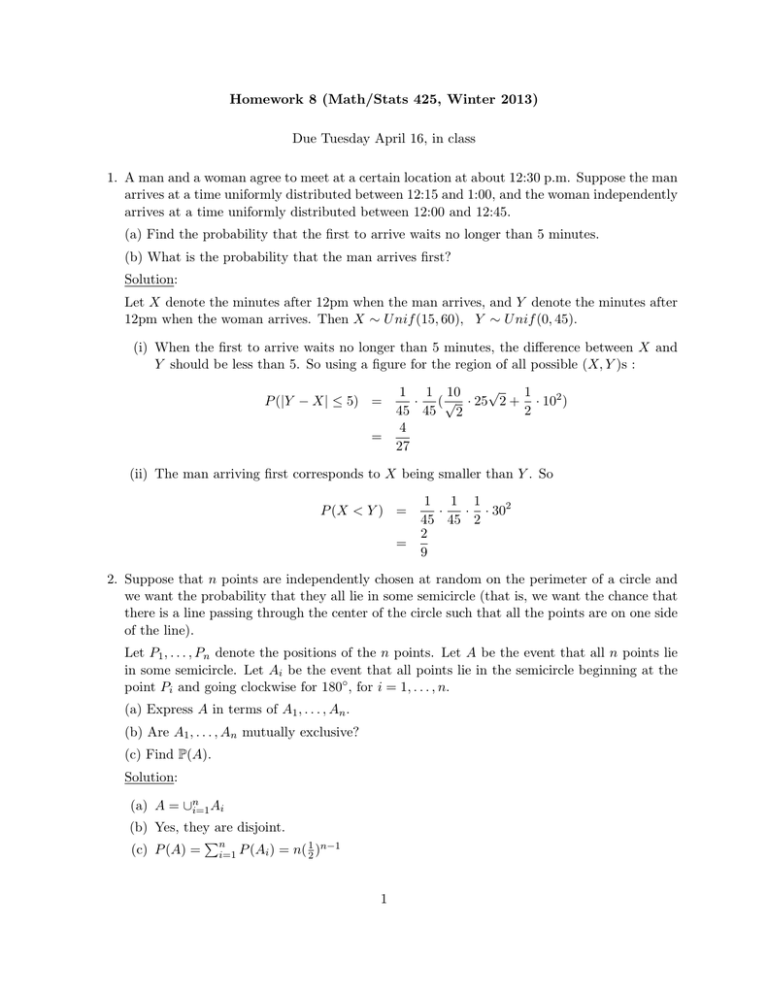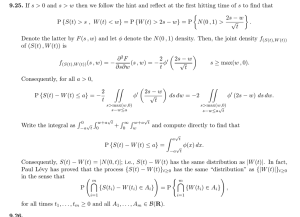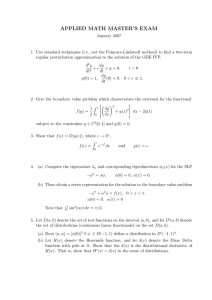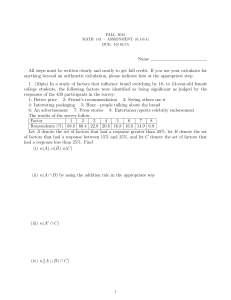Homework 8 (Math/Stats 425, Winter 2013) Due Tuesday April 16, in
advertisement

Homework 8 (Math/Stats 425, Winter 2013)
Due Tuesday April 16, in class
1. A man and a woman agree to meet at a certain location at about 12:30 p.m. Suppose the man
arrives at a time uniformly distributed between 12:15 and 1:00, and the woman independently
arrives at a time uniformly distributed between 12:00 and 12:45.
(a) Find the probability that the first to arrive waits no longer than 5 minutes.
(b) What is the probability that the man arrives first?
Solution:
Let X denote the minutes after 12pm when the man arrives, and Y denote the minutes after
12pm when the woman arrives. Then X ∼ U nif (15, 60), Y ∼ U nif (0, 45).
(i) When the first to arrive waits no longer than 5 minutes, the difference between X and
Y should be less than 5. So using a figure for the region of all possible (X, Y )s :
P (|Y − X| ≤ 5) =
=
√
1 1 10
1
· ( √ · 25 2 + · 102 )
45 45 2
2
4
27
(ii) The man arriving first corresponds to X being smaller than Y . So
P (X < Y ) =
=
1 1 1
·
· · 302
45 45 2
2
9
2. Suppose that n points are independently chosen at random on the perimeter of a circle and
we want the probability that they all lie in some semicircle (that is, we want the chance that
there is a line passing through the center of the circle such that all the points are on one side
of the line).
Let P1 , . . . , Pn denote the positions of the n points. Let A be the event that all n points lie
in some semicircle. Let Ai be the event that all points lie in the semicircle beginning at the
point Pi and going clockwise for 180◦ , for i = 1, . . . , n.
(a) Express A in terms of A1 , . . . , An .
(b) Are A1 , . . . , An mutually exclusive?
(c) Find P(A).
Solution:
(a) A = ∪ni=1 Ai
(b) Yes, they are disjoint.
P
(c) P (A) = ni=1 P (Ai ) = n( 21 )n−1
1
3. The joint density function of X and Y is given by
x + y 0 < x < 1, 0 < y < 1
f (x, y) =
0
else
(a) Are X and Y independent?
(b) Find the marginal density function of X.
(c) Find P(X + Y < 1).
Solution:
(a,b)
Z
1
fX (x) =
Z
1
f (x, y)dy =
(x + y)dy
0
0
= x+
1
2
fY (y) = y +
1
2
Since f (x, y) 6= fX (x)fY (y), they are not independent.
(c)
Z
1 Z 1−x
P (X + Y < 1) =
f (x, y)dydx
0
Z
0
1 Z 1−x
=
(x + y)dydx
0
Z
0
1
(x(1 − x) +
=
0
Z
=
(−
0
=
1
(1 − x)2
)dx
2
x2 1
+ )dydx
2
2
1
3
4. Suppose X1 and X2 are independent exponential random variables with parameters λ1 and
λ2 respectively.
(a) Obtain the density of Z = X1 /X2 .
(b) Compute P(X1 < X2 ).
Solution: Since X1 and X2 are independent, the joint density of X1 and X2 is
fX1 ,X2 (x, y) = λ1 e−λ1 x λ2 e−λ2 y ,
2
x, y > 0
Let Z =
X1
X2 .
Then the distribution of Z is
FZ (z) = P (Z ≤ z)
X1
= P(
≤ z)
X2
= P (X1 ≤ zX2 )
Z ∞ Z zy
=
λ1 e−λ1 x λ2 e−λ2 y dxdy
Z0 ∞ 0
=
(1 − e−λ1 zy )λ2 e−λ2 y dy
0
λ2
λ1 z + λ2
λ1 z
λ1 z + λ2
= 1−
=
fZ (z) =
=
=
d
FZ (z)
dz
d
λ1 z
dz λ1 z + λ2
λ1 λ2
(λ1 z + λ2 )2
And also
X1
< 1)
X2
= P (Z < 1)
λ1
=
λ1 + λ2
P (X1 < X2 ) = P (
5. Jill’s bowling scores are approximately normally distributed with mean 170 and standard
deviation 20, whereas Jack’s scores are approximately normally distributed with mean 160
and standard deviation 15. If Jack and Jill each bowl one game, approximate the probability
that
(a) Jack’s score is higher;
(b) the total of their scores is above 350.
Explain any assumptions you may require that are not explicitly specified in the question.
Solution:
Let X denote Jill’s score and let Y denote Jack’s score. Also, let Z be a standard normal
random variable.
(a)
P {Y > X} = P {Y − X > 0}
Y − X − (160 − 170)
10
√
= P
>√
202 + 152
202 + 152
= P {Z > 0.4} ≈ 0.3372
3
(b)
20
X + Y − 330
√
P {X + Y > 350} = P
>√
2
2
2
20 + 15
20 + 152
= P {Z > 0.8} ≈ 0.2061
6. Let X1 , X2 , . . . , Xn be n independent and identically distributed continuous random variables,
each with density f . Let Z be the largest value taken by any of these random variables,
Z = max{X1 , X2 , . . . , Xn }.
Find the probability density function of Z.
Solution:
FZ (z) = P (Z ≤ z)
= P (X1 ≤ z)n
= F (z)n
d
FZ (z)
dz
= nf (z)F (z)n−1
fZ (z) =
Recommended reading:
Sections 6.2, 6.3, 6.4, 6.5 in Ross “A First Course in Probability,” 8th edition.
4





